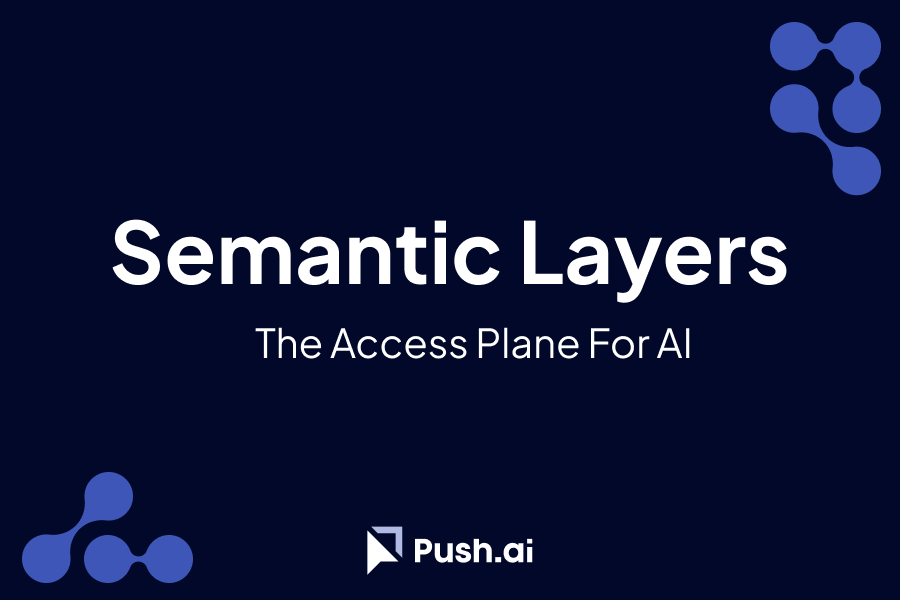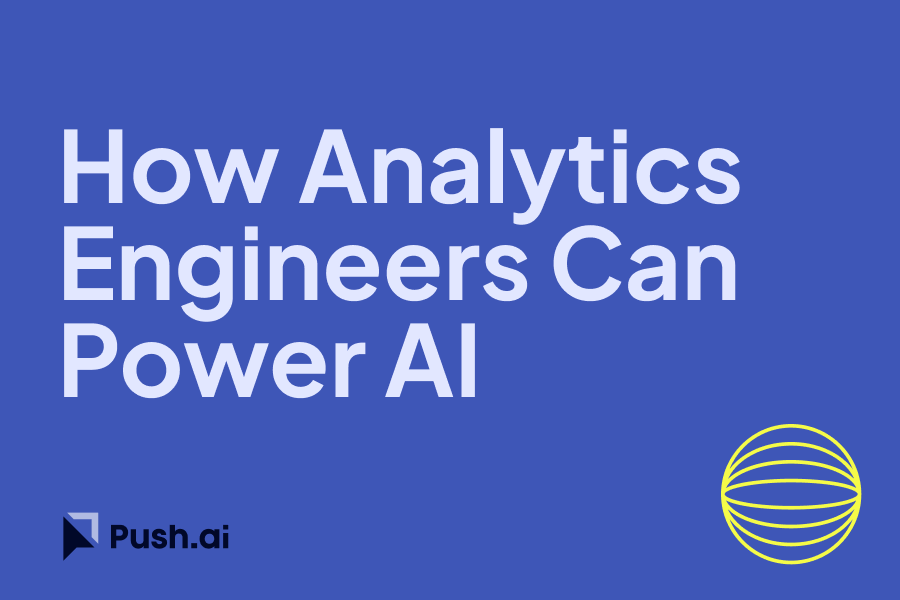The modern data warehouse has become the single source of truth for analytics, but without structure and governance, it can also become the single source of chaos. As data volumes grow and AI tools begin querying directly against production datasets, data teams need a way to control access, define meaning, and ensure that every query — human or AI — produces results that are both consistent and explainable.
That’s where the semantic layer comes in.
The semantic layer is not a new concept, but it’s being reimagined for the AI era — as a living, queryable map of the business that connects data to meaning. It provides a governed, deterministic interface between raw data and every tool or model that consumes it.
1. What It Means to Govern Access Through a Semantic Layer
At its core, the semantic layer defines how data should be interpreted and accessed. It includes the business definitions for objects like metrics, dimensions, entities, and time — and enforces them across every interface, from BI dashboards to AI agents.
Instead of every tool generating its own version of “revenue,” the semantic layer provides a single definition that everyone — and every system — uses. This is what makes queries deterministic: given the same inputs, they always produce the same results.
In an era when AI can generate new queries on the fly, determinism matters more than ever. Without it, the same question asked two different ways can yield conflicting answers — undermining trust in data and in AI itself.
A governed semantic layer provides:
- Consistent definitions across all tools (BI, AI, SQL).
- Role-based access control to prevent exposure of sensitive data.
- Business-friendly metadata that bridges human language and technical logic.
- Query determinism — every query aligns to the same semantic definitions and lineage.
2. The Tension Between Determinism and AI’s Non-Determinism
AI models, by nature, are non-deterministic. Ask the same model the same question twice and it may phrase its answer differently — or even make subtly different assumptions in how it queries data. That flexibility makes AI powerful for exploration, but risky for measurement.
The semantic layer provides a fixed reference frame for this otherwise variable system. By defining measures, dimensions, entities, and relationships explicitly, it gives the AI guardrails to operate within.
In other words:
The semantic layer defines what is true; AI defines how to explore it.
This partnership allows AI to accelerate analysis without sacrificing trust. The AI can ask exploratory questions, but when it translates those into warehouse queries, it’s doing so against a deterministic schema that the business has vetted.
3. Why Text-to-SQL Alone Isn’t Enough
Text-to-SQL is an exciting frontier — but it’s not a governance strategy.
Without a semantic layer, text-to-SQL systems rely on natural language interpretation alone, which can easily lead to incorrect joins, misunderstood metrics, or unoptimized queries. While they’re great for exploration, they’re risky for decision-making.
Text-to-SQL is valuable for:
- Quickly exploring unfamiliar datasets.
- Generating first-pass insights in ad-hoc scenarios.
- Empowering analysts to experiment and iterate.
But it’s not a replacement for a modeled, governed data layer. The right approach is to combine both: use text-to-SQL for discovery, and the semantic layer for production-grade insights.
4. The Next Evolution: Semantic Layers for Unstructured and Hybrid Data
The traditional semantic layer focuses on structured data — columns, joins, metrics. But businesses today generate vast amounts of unstructured and semi-structured data: documents, emails, tickets, product logs, meeting notes. These sources contain valuable context that rarely makes it into dashboards.
The next generation of semantic layers — like Push.ai’s business semantic layer — expand beyond structured tables to map these unstructured signals into a unified graph of business meaning.
This requires a richer, multi-type model of the data environment — one that understands both quantitative and qualitative signals, and represents them as first-class entities in the model.
5. How Push.ai Models the Semantic Layer
Push.ai’s semantic layer is designed from the ground up for AI alignment and business context. It enables deterministic analytics with a schema that captures not only the metrics, but also the relationships, entities, and metadata that give meaning to the data.
The Push.ai model includes:
TypePurposeExampleMeasuresQuantitative fields used in aggregationsRevenue, Sessions, Tickets CreatedMetricsNamed, governed business metrics with formulas and lineageGross Margin, Active UsersModelsdbt or warehouse models that form the base of analysisfct_orders, dim_customersDimensionsGrouping fields tied to measuresRegion, Product CategoryDimension ValuesEnumerated values within a dimension“North America”, “APAC”EntitiesSemantic business objects that represent nouns in the organizationCustomer, Account, CampaignEntity ValuesSpecific instances of entities“Acme Corp”, “Q2 Launch Campaign”AttributesDescriptive properties tied to entitiesIndustry, ARR, Team OwnerTimeTemporal context that structures all trendsTransaction Date, Signup Week
Each of these objects is typed, queryable, and described — with synonyms, naming conventions, and metadata that make them discoverable through natural language.
When AI queries Push.ai’s layer, it doesn’t just see tables — it sees meaning. It knows what a “Customer” is, how “Revenue” is calculated, and which dimensions are valid to group by.
This creates a shared semantic fabric that makes every AI-generated insight traceable, reproducible, and aligned with business truth.
6. Metadata and Context as the Intelligence Layer
What makes Push.ai’s approach distinct is that it doesn’t stop at structure. It also indexes:
- Descriptions (plain-language definitions of every element)
- Synonyms (alternate phrasings for how users describe data)
- Smart naming conventions (pattern-aware labels for entities and metrics)
- Linked documents (contextual materials that describe data lineage, use cases, or business meaning)
This metadata layer serves as a bridge between human context and machine precision — powering semantic search, question-answering, and context retrieval for both analysts and AI agents.
When someone (or something) asks, “What’s our churn rate in Europe last quarter?”, Push.ai’s semantic search can resolve the correct metric, filter dimensions, and time context before the query is even executed.
7. The Future of Semantic Layers
Semantic layers are evolving from passive metadata catalogs into active reasoning systems — the connective layer that allows AI and BI to operate safely, consistently, and intelligently over enterprise data.
As data teams adopt AI agents and autonomous workflows, the semantic layer becomes not just a translation layer, but a governance and trust interface — the foundation on which reliable, explainable AI analytics can be built.
In short:
- Without a semantic layer, AI is flying blind.
- With one, AI becomes a disciplined, governed participant in the analytics ecosystem.
Push.ai is building that bridge — where semantic structure meets intelligent exploration, and where AI and humans can query the same data, with the same meaning, and trust the results every time.


%201.svg)






